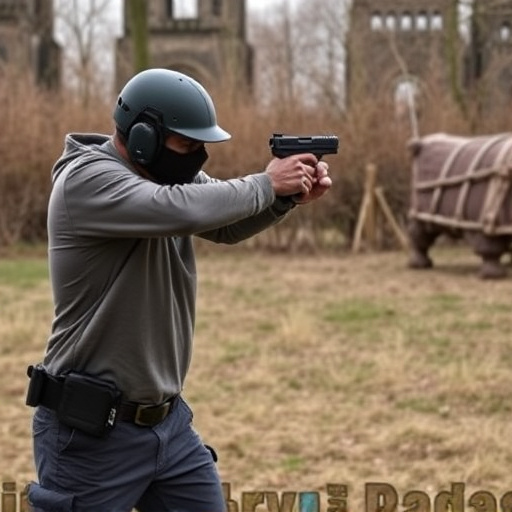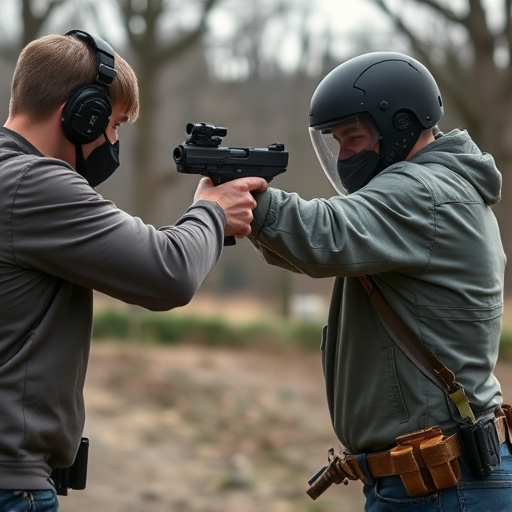The neuromuscular effects of stun devices like stun guns or ECDs rely on delivering precise electric currents (5,000V-15,000V) through metal probes to disrupt the attacker's nervous system, causing temporary immobilization. This voltage range balances muscular control disruption and prevents lasting harm. Key safety features include energy output control, pulse width modulation, and circuit protection. Effective usage involves adhering to local laws, proper training, and understanding device limitations to ensure responsible ownership and mitigate risks for both users and bystanders.
“The neuromuscular effects of stun devices have sparked interest and concern alike. This article delves into the intricate workings of these devices, focusing on the critical aspect of voltage range and its safety implications. We explore key factors ensuring stun gun effectiveness and safety, including regulatory guidelines for responsible use. Understanding the neuromuscular impact and adhering to safety specs are paramount for effective self-defense while mitigating risks associated with these powerful tools.”
- Understanding Neuromuscular Effects: How Stun Devices Work
- Safety Specifications: Voltage Range and Its Impact
- Key Factors in Stun Gun Safety and Effectiveness
- Regulatory Considerations and Best Practices for Users
Understanding Neuromuscular Effects: How Stun Devices Work

The neuromuscular effects of stun devices are a key aspect to understand when evaluating their safety and effectiveness. Stun guns, also known as tactical electronic control devices (ECDs), work by delivering an electric current through two metal probes into the target’s body. This sudden impulse disrupts the electrical signals that control muscle movements, causing involuntary contractions and resulting in temporary immobilization. The voltage range of these devices is critical; it must be high enough to overpower the target’s nervous system but not so high as to cause permanent harm or cardiac arrest.
Manufacturers typically specify a voltage range for stun guns, often between 5,000V and 15,000V, with some models reaching even higher. Within this range, the device’s current is designed to be low enough to prevent severe injuries but sufficient to disable an attacker momentarily. The neuromuscular effects are rapid and can last for several minutes, providing users with valuable time to escape or seek help. Safety specs also include guidelines on energy output control, pulse width modulation, and circuit protection mechanisms to ensure the stun device operates within safe parameters and minimizes risks to users and bystanders.
Safety Specifications: Voltage Range and Its Impact

Stun guns, also known as electronic control devices (ECDs), use a specific voltage range to achieve their neuromuscular effects and incapacitate targets. The safety specifications for stun guns closely revolve around this voltage range, which varies between 5,000 and 15,000 volts, depending on the device’s design and purpose. This range is crucial in ensuring the device delivers enough current to disrupt muscular control without causing severe or permanent damage to the target.
Lower voltages within this range may produce a numbing sensation, making it difficult for an individual to move, while higher voltages can lead to more intense neuromuscular responses, including muscle spasms and temporary paralysis. It’s essential for users to understand that these devices are designed for self-defense purposes only and should be used responsibly, adhering to local laws and guidelines, to ensure both personal safety and the safety of others around them.
Key Factors in Stun Gun Safety and Effectiveness

The safety and effectiveness of a stun gun hinge on understanding the neuromuscular effects these devices impart. When a stun gun delivers its electric shock, it disrupts the electrical impulses that control muscle movements in the body. This disruption leads to a strong, sudden contraction of muscles, which can immobilize an assailant momentarily. The key to a stun gun’s success lies in delivering enough voltage to achieve this neuromuscular blockade without causing serious harm or permanent damage.
Several factors contribute to a stun gun’s safety profile. First, the voltage range plays a crucial role: it needs to be high enough to override an assailant’s resistance but not so high as to cause significant tissue damage. Additionally, the device’s design and construction matter; they must ensure accurate current delivery to the target area while minimizing off-target shocks and accidental discharge. Moreover, user training is essential to ensure safe and effective use, including understanding the device’s limitations and when to employ it appropriately.
Regulatory Considerations and Best Practices for Users

In the realm of stun gun safety, regulatory considerations play a pivotal role in ensuring user protection and responsible device deployment. When discussing the neuromuscular effects of stun devices, it’s crucial to align with local laws and industry standards. Each jurisdiction has its own set of guidelines governing stun guns, including power output limits, safety features required, and prohibited areas for use or carry. Adhering to these regulations not only ensures legal compliance but also promotes user safety by minimizing the risk of unintended harm.
Best practices for users go hand in hand with regulatory adherence. Users should be educated on the specific neuromuscular effects their stun device is designed to induce, typically through high-voltage electrical discharge. This knowledge empowers users to employ the device effectively while understanding its limitations and potential risks. Additionally, best practices involve maintaining devices in good working condition, ensuring proper training in usage, and being aware of safe handling procedures. These measures contribute to responsible stun gun ownership and usage, fostering a safer environment for all.
Understanding the neuromuscular effects of stun devices is key to appreciating their functionality. By knowing how these devices disrupt motor control, we can better grasp their safety specifications, particularly within voltage ranges that maximize impact while minimizing harm. Key factors in stun gun safety and effectiveness include proper usage training, maintaining device integrity, and adhering to regulatory considerations. Users should be educated on best practices to ensure the safe and effective deployment of stun devices, leveraging their power responsibly and with confidence.
